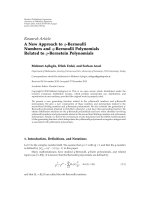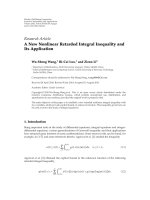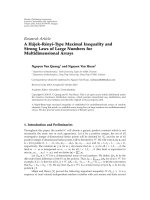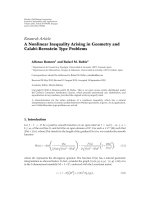Báo cáo hóa học: " Research Article A New Approach to q-Bernoulli Numbers and q-Bernoulli Polynomials Related to q-Bernstein Polynomials" pdf
Bạn đang xem bản rút gọn của tài liệu. Xem và tải ngay bản đầy đủ của tài liệu tại đây (491.62 KB, 9 trang )
Hindawi Publishing Corporation
Advances in Difference Equations
Volume 2010, Article ID 951764, 9 pages
doi:10.1155/2010/951764
Research Article
A New Approach to q-Bernoulli
Numbers and q-Bernoulli Polynomials
Related to q-Bernstein Polynomials
Mehmet Ac¸ikg
¨
oz, Dilek Erdal, and Serkan Araci
Department of Mathematics, Faculty of Science and Arts, University of Gaziantep, 27310 Gaziantep, Turkey
Correspondence should be addressed to Mehmet Ac¸ikg
¨
oz,
Received 24 November 2010; Accepted 27 December 2010
Academic Editor: Claudio Cuevas
Copyright q 2010 Mehmet Ac¸ikg
¨
oz et al. This is an open access article distributed under the
Creative Commons Attribution License, which permits unrestricted use, distribution, and
reproduction in any medium, provided the original work is properly cited.
We present a new generating function related to the q-Bernoulli numbers and q-Bernoulli
polynomials. We give a new construction of these numbers and polynomials related to the
second-kind Stirling numbers and q-Bernstein polynomials. We also consider the generalized q-
Bernoulli polynomials attached to Dirichlet’s character χ and have their generating function. We
obtain distribution relations for the q-Bernoulli polynomials and have some identities involving
q-Bernoulli numbers and polynomials related to the second kind Stirling numbers and q-Bernstein
polynomials. Finally, we derive the q-extensions of zeta functions from the Mellin transformation
of this generating function which interpolates the q-Bernoulli polynomials at negative integers and
is associated with q-Bernstein polynomials.
1. Introduction, Definitions, and Notations
Let C be the complex number field. We assume that q ∈ C with |q| < 1 and that the q-number
is defined by x
q
q
x
− 1/q − 1 in this paper.
Many mathematicians have studied q-Bernoulli, q-Euler polynomials, and related
topics see 1–23. It is known that the Bernoulli polynomials are defined by
t
e
t
− 1
e
xt
∞
n0
B
n
x
t
n
n!
, for
|
t
|
< 2π, 1.1
and that B
n
B
n
0 are called the nth Bernoulli numbers.
2 Advances in Difference Equations
The recurrence formula f or the classical Bernoulli numbers B
n
is as follows,
B
0
1,
B 1
n
− B
n
0, if n>0 1.2
see 1, 3, 23.Theq-extension of the following recurrence f ormula for the Bernoulli numbers
is
B
0,q
1,q
qB 1
n
− B
n,q
⎧
⎨
⎩
1, if n 1,
0, if n>1,
1.3
with the usual convention of replacing B
n
by B
n,q
see 5, 7, 14.
Now, by introducing the following well-known identities
x y
q
x
q
q
x
y
q
,
−x
q
−
1
q
x
x
q
,
xy
q
x
q
y
q
x
1.4
see 6.
The generating functions of the second kind Stirling numbers and q-Bernstein
polynomials, respectively, can be defined as follows,
e
t
− 1
k
k!
∞
n0
S
n, k
t
n
n!
, 1.5
F
k
x, t; q
t
x
q
k
k!
e
t1−x
q
∞
n0
B
k,n
x; q
t
n
n!
,t∈ C,k 0, 1, ,n
1.6
see 2, where lim
q → 1
F
k
x, t; qF
k
t, xtx
k
/k!e
t1−x
see 4.
Throughout this paper, Z, Q, Z
p
, Q
p
,andC
p
will respectively denote the ring of rational
integers, the field of rational numbers, the ring p-adic rational integers, the field of p-adic
rational numbers, and the completion of the algebraic closure of Q
p
.Letv
p
be the normalized
exponential valuation of C
p
such that |p|
p
p
−v
p
p
1/p.Ifq ∈ C
p
, we normally assume
|q − 1|
p
<p
−1/p−1
or |1 − q|
p
< 1sothatq
x
expx log q for |x|
p
≤ 1 see 7–19.
In this study, we present a new generating function related to the q-Bernoulli
numbers and q-Bernoulli polynomials and give a new construction of these numbers and
polynomials related to the second kind Stirling numbers and q-Bernstein polynomials. We
also consider the generalized q-Bernoulli polynomials attached to Dirichlet’s character χ
and have their generating function. We obtain distribution relations for the q-Bernoulli
polynomials and have some identities involving q-Bernoulli numbers and polynomials
related to the second kind Stirling numbers and q-Bernstein polynomials. Finally, we derive
the q-extensions of zeta functions from the Mellin transformation of this generating function
Advances in Difference Equations 3
which interpolates the q-Bernoulli polynomials at negative integers and are associated with
q-Bernstein polynomials.
2. New Approach to q-Bernoulli Numbers and Polynomials
Let N be the set of natural numbers and N
∗
N ∪{0}. For q ∈ C with |q| < 1, let us define the
q-Bernoulli polynomials B
n,q
x as follows,
D
q
t, x
−t
∞
y0
q
y
e
xyt
∞
n0
B
n,q
x
t
n
n!
.
2.1
Note that
lim
q → 1
D
q
t, x
t
e
t
− 1
e
xt
∞
n0
B
n
x
t
n
n!
,
|
t
|
< 2π,
2.2
where B
n
x are classical Bernoulli polynomials. In the special case x 0, B
n,q
B
n,q
0 are
called the nth q-Bernoulli numbers. That is,
D
q
t
D
q
t, 0
−t
∞
y0
q
y
e
yt
∞
n0
B
n,q
t
n
n!
.
2.3
From 2.1 and 2.3,wenotethat
qD
q
t, 1
− D
q
t
qe
t
D
q
qt
− D
q
t
q
∞
l0
t
l
l!
∞
m0
q
m
B
m,q
t
m
m!
−
∞
n0
B
n,q
t
n
n!
q
∞
n0
n
l0
n
l
q
l
B
l,q
t
n
n!
−
∞
n0
B
n,q
t
n
n!
.
2.4
From 2.1 and 2.3, we can easily derive the following equation:
qD
q
t, 1
− D
q
t
1. 2.5
Equations 2.4 and 2.5,weseethatB
0,q
1and
n
l0
n
l
q
l1
B
l,q
− B
n,q
⎧
⎨
⎩
1, if n 0
0, if n>0.
2.6
Therefore, we obtain the following theorem.
4 Advances in Difference Equations
Theorem 2.1. For n ∈ N
∗
, one has
B
0,q
1,q
qB 1
n
− B
n,q
⎧
⎨
⎩
1, if n 0
0, if n>0.
2.7
with the usual convention of replacing B
i
and B
i,q
.
From 2.1, one notes that
D
q
t, x
e
x
q
t
D
q
q
x
t
∞
n0
x
n
q
t
n
n!
∞
n0
q
nx
B
n,q
t
n
n!
∞
n0
n
l0
n
l
q
lx
B
l,q
x
n−l
q
t
n
n!
.
2.8
Therefore, one obtains the following theorem.
Theorem 2.2. For n ∈ N
∗
, one has
B
n,q
x
n
l0
n
l
q
lx
B
l,q
x
n−l
q
. 2.9
By 2.1, one sees that
D
q
t, x
∞
n0
−t
∞
m0
q
m
x m
n
q
t
n
n!
∞
n0
1
1 − q
n
n
l0
n
l
−1
l
q
lx
l 1
l 1
q
t
n
n!
.
2.10
By 2.1 and 2.10, one obtains the following theorem.
Theorem 2.3. For n ∈ N
∗
, one has
B
n,q
x
1
1 − q
n
n
l0
n
l
−1
l
q
lx
l 1
l 1
q
. 2.11
From 2.11 one can derive that, for s ∈ N,
D
q
t, x
s−1
a0
q
a
D
q
s
t
s
q
,
x a
s
.
2.12
Advances in Difference Equations 5
By 2.12, one sees that, for s ∈ N,
∞
n0
B
n,q
x
t
n
n!
∞
n0
s
n
q
s−1
a0
q
a
B
n,q
s
x a
s
t
n
n!
.
2.13
Therefore, one obtains the following theorem.
Theorem 2.4. For s ∈ N
∗
, one has
B
n,q
x
s
n
q
s−1
a0
q
a
B
n,q
s
x a
s
.
2.14
In 2.9, substitute 1 − x instead of x,oneobtains
B
n,q
1 − x
n
v0
n
v
B
v,q
q
v1−x
1 − x
n−v
q
n
v0
n
v
x
v
q
1 − x
n−v
q
B
v,q
· q
v1−x
x
−v
q
∞
m0
n
v0
B
v,n
x; q
v m − 1
m
q
v
1 − q
m
x
m−v
q
B
v,q
,
2.15
which is the relation between q-Bernoulli polynomials, q-Bernoulli numbers, and q-Bernstein
polynomials. In 1.5, substitute x log q instead of t,onegets
x
k
q
k!
q − 1
k
∞
y0
S
y, k
x log q
y
y!
.
2.16
In 2.16, substitute m − v instead of k, and putting the result in 2.15, one has the following
theorem.
Theorem 2.5. For n ∈ N
∗
and |q| < 1, one has
B
n,q
x
∞
m,y0
n
v0
v
j0
v m − 1
m
v
j
−1
m−vj
m − v
!q
vj
y!
× S
y, m − v
B
n−v,n
x; q
B
v,q
x log q
y
,
2.17
where Sk, nand B
k,n
x; q are the second kind Stirling numbers and q-Bernstein polynomials,
respectively.
6 Advances in Difference Equations
Let χ be Dirichlet’s character with s ∈ N. Then, one defines the generalized q-Bernoulli
polynomials attached to χ as follows,
D
q,χ
t, x
−t
∞
d0
χ
d
q
d
e
dx
q
t
∞
n0
B
n,χ,q
x
t
n
n!
.
2.18
In the special case x 0, B
n,χ,q
B
n,χ,q
0 are called the nth generalized q-Bernoulli
numbers attached to χ. Thus, the generating function of the generalized q-Bernoulli numbers
attached to χ are as follows,
D
q,χ
t, x
−t
∞
d0
χ
d
q
d
e
d
q
t
∞
n0
B
n,χ,q
t
n
n!
.
2.19
By 2.1 and 2.18, one sees that
D
q,χ
t, x
s−1
a0
q
a
χ
a
D
q
s
t
s
q
,
x a
s
∞
n0
s
n
q
s−1
a0
q
a
χ
a
B
n,q
s
x a
s
t
n
n!
.
2.20
Therefore, one obtains the following theorem.
Theorem 2.6. For n ∈ N
∗
and s ∈ N, one has
B
n,χ,q
x
s
n
q
s−1
a0
q
a
χ
a
B
n,q
s
x a
s
.
2.21
By 2.18 and 2.19, one sees that
D
q,χ
t, x
e
x
q
t
D
q,χ
q
x
t
∞
n0
n
d0
n
d
q
dx
x
n−d
q
B
d,χ,q
t
n
n!
. 2.22
Hence,
B
n,χ,q
x
n
d0
n
d
q
dx
x
n−d
q
B
d,χ,q
. 2.23
Advances in Difference Equations 7
For s ∈ C, one now considers the Mellin transformation for the generating function of
D
q
t, x.Thatis,
1
Γ
s
∞
0
D
q
−t, x
t
s−2
dt
∞
n0
q
n
x n
s
q
,
2.24
for s ∈ C,andx
/
0, −1, −2,
From 2.24, one defines the zeta type function as follows,
ζ
q
s, x
∞
n0
q
n
x n
s
q
,s∈ C,x
/
0, −1, −2,
2.25
Note that ζ
q
s, x is an analytic function in the whole complex s-plane. Using the Laurent
series and the Cauchy residue theorem, one has
−nζ
q
1 − n, x
B
n,q
x
, for n ∈ N
∗
.
2.26
By the same method, one can also obtain the following equations:
1
Γ
s
∞
0
D
q,χ
−t, x
t
s−2
dt
∞
n0
χ
n
q
n
n x
s
q
.
2.27
For s ∈ C,one defines Dirichlet type q-l-function as
l
q
s, x | χ
∞
n0
χ
n
q
n
n x
s
q
,
2.28
where x
/
0, −1, −2, Notethatl
q
s, x | χ is also a holomorphic function in the whole
complex s-plane. From the Laurent series and the Cauchy residue theorem, one can also
derive the following equation:
−nl
q
1 − n, x | χ
B
n,χ,q
x
. 2.29
In 2.23, substitute 1 − x instead of x,oneobtains
B
n,χ,q
1 − x
n
v0
n
v
B
v,χ,q
q
v1−x
1 − x
n−v
q
n
v0
n
v
x
v
q
1 − x
n−v
q
B
v,χ,q
· q
v1−x
x
−v
q
∞
m0
n
v0
B
v,n
x; q
v m − 1
m
q
v
1 − q
m
x
m−v
q
B
v,χ,q
,
2.30
8 Advances in Difference Equations
which is the relation between the nth generalized q-Bernoulli numbers and q-Bernoulli
polynomials attached to χ and q-Bernstein polynomials. From 2.16, one has the following
theorem.
Theorem 2.7. For n ∈ N
∗
and |q| < 1, one has
B
n,χ,q
x
∞
m,y0
n
v0
v
j0
v m − 1
m
v
j
−1
m−vj
m − v
!q
vj
y!
× S
y, m − v
B
n−v,n
x; q
B
v,χ,q
x log q
y
.
2.31
One now defines particular q-zeta function as follows,
H
q
s, a | F
m≡a
mod F
q
m
m
s
q
.
2.32
From 2.32, one has
H
q
s, a | F
q
a
F
s
q
ζ
∗
q
F
s,
a
F
, 2.33
where ζ
∗
q
F
s, a/F is given by 2.25.By2.26, one has
H
q
1 − n, a | F
−
q
a
F
n−1
q
B
n,q
F
a/F
n
,n∈ N.
2.34
Therefore, one obtains the following theorem.
Theorem 2.8. For n ∈ N, we have
B
n,q
F
a
F
−
nH
q
1 − n, a | F
q
a
F
n−1
q
.
2.35
References
1 M. Ac¸ıkg
¨
oz and S. Aracı, “The relations between Bernoulli, Bernstein and Euler polynomials,” in
Proceedings of the 8th International Conference of Numerical Analysis and Applied Mathematics (ICNAAM
’10), AIP, Rhodes, Greece, March 2010.
2 M. Ac¸ıkg
¨
oz and Y. S¸ims¸ ek, “A new generating function of q-Bernstein-type polynomials and their
interpolation function,” Abstract and Applied Analysis, vol. 2010, Article ID 769095, 12 pages, 2010.
3 M. Ac¸ıkg
¨
oz and Y. S¸ims¸ek, “On multiple interpolation functions of the Norlund-type Euler
polynomials,” Abstract Applied Analysis, vol. 2009, Article ID 382574, 14 pages, 2009.
4 M. Ac¸ıkg
¨
oz and S. Aracı, “On the generating function of Bernstein polynomials,” in Proceedings of the
8th International Conference of Numerical Analysis and Applied Mathematics (ICNAAM ’10), AIP, Rhodes,
Greece, March 2010.
5 L. Carlitz, “q-Bernoulli numbers and polynomials,” Duke Mathematical Journal, vol. 15, pp. 987–1000,
1948.
Advances in Difference Equations 9
6 V. Kac and P. Cheung, Quantum Calculus, Universitext, Springer, New York, NY, USA, 2001.
7 T. Kim, “A new approach to q-zeta function,” Advanced Studies in Contemporary Mathematics, vol. 11,
no. 2, pp. 157–162, 2005.
8 T. Kim, “q-Volkenborn integration,” Russian Journal of Mathematical Physics, vol. 9, no. 3, pp. 288–299,
2002.
9 T. Kim, “On p-adic q-L-functions and sums of powers,” Discrete Mathematics, vol. 252, no. 1–3, pp.
179–187, 2002.
10 T. Kim, “q-Bernoulli numbers and polynomials associated with Gaussian binomial coefficients,”
Russian Journal of Mathematical Physics, vol. 15, no. 1, pp. 51–57, 2008.
11 T. Kim, “Non-Archimedean q-integrals associated with multiple Changhee q-Bernoulli polynomials,”
Russian Journal of Mathematical Physics, vol. 10, no. 1, pp. 91–98, 2003.
12 T. Kim, “Power series and asymptotic series associated with the q-analog of the two-variable p-adic
L-function,” Russian Journal of Mathematical Physics, vol. 12, no. 2, pp. 186–196, 2005.
13 T. Kim, “On the q-extension of Euler and Genocchi numbers,” Journal of Mathematical Analysis and
Applications, vol. 326, no. 2, pp. 1458–1465, 2007.
14 T. Kim, J. Choi, and Y H. Kim, “q-Bernstein polynomials associated with q-Stirling numbers and
Carlitz’s q-Bernoulli numbers,” Abstract and Applied Analysis in press.
15 T. Kim, L C. Jang, and H. Yi, “A note on the modified q-Bernstein polynomials,” Discrete Dynamics in
Nature and Society
, vol. 2010, Article ID 706483, 12 pages, 2010.
16 T. Kim, “q-Bernstein polynomials, q-Stirling numbers and q-Bernoulli polynomials,” http://arxiv
.org/abs/1008.4547.
17 T. Kim, L C. Jang, Y. Kim, and J. Choi, “On p-adic analogue of q-Bernstein polynomials and related
integrals,” Discrete Dynamics in Nature and Society, vol. 2010, Article ID 179430, 9 pages, 2010.
18 T. Kim, J. Choi, and Y H. Kim, “Some identities on the q-Bernstein polynomials, q-Stirling numbers
and q-Bernoulli numbers,” Advanced Studies in Contemporary Mathematics, vol. 20, pp. 335–341, 2010.
19 T. Kim, “Analytic continuation of multiple q-zeta functions and their values at negative integers,”
Russian Journal of Mathematical Physics, vol. 11, no. 1, pp. 71–76, 2004.
20 T. Kim, “Note on the Euler q-zeta functions,” Journal of Number Theory, vol. 129, no. 7, pp. 1798–1804,
2009.
21 T. Kim, “Barnes-type multiple q-zeta functions and q-Euler polynomials,” Journal of Physics A, vol. 43,
no. 25, Article ID 255201, 11 pages, 2010.
22 T. Kim, S H. Rim, J W. Son, and L C. Jang, “On the values of q-analogue of zeta and L-functions. I,”
Algebra Colloquium, vol. 9, no. 2, pp. 233–240, 2002.
23 H. Rademacher, Topics in Analytic Number Theory, Springer, New York, NY, USA, 1973.









